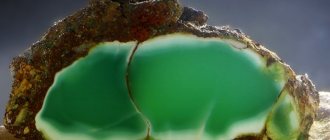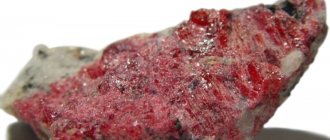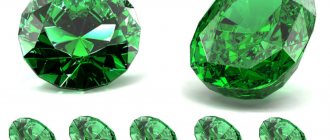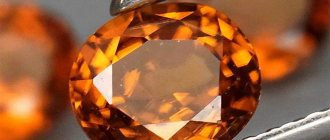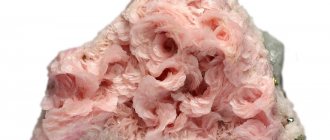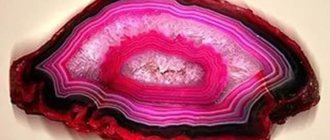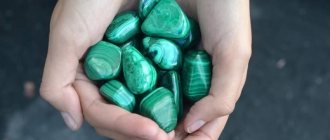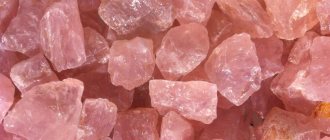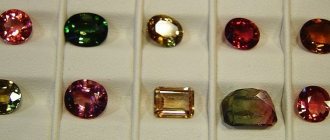Spinel is a trickster stone that has been featured on crowns for centuries, like its more expensive counterpart, the ruby.
Spinel surpasses ruby in its brilliance and depth.
It can be scarlet red, mysterious green, soft blue, deep green and even coal black. The beauty of a stone can only be outshone by the beauty of its history.
History and origin
The name of the stone - spinel - Spinell, came to us from the German language. The word may have Latin roots, from spina (“thorn”), which can be associated with pointed crystals, or Greek roots, from the word σπίν(ν)ος (“shine”).
Gem mining has been carried out since ancient times; the first information about mining in the Pamir Mountains from the 9th century came to us thanks to Marco Polo, a traveler of the 13th century. He called spinel deposits “ruby mines.” The fact is that all valuable red-pink gemstones were then called “lal”, without division: spinel, ruby, garnet, red tourmaline.
Spinel
This word, which has roots in the Hindi and Farsi languages, was passed down through generations in different ethnic groups for centuries, and was used in ordinary speech and trade until the 13th century, along with the collective concepts of other precious stones: yakhont and carbuncle. It was preserved in the folk epic. Then, until the 18th century, the name “lal” (“lal”) was used only in relation to red spinel as a stone inferior in its jewelry value to ruby, but superior to garnet and other red gems that fall into this group.
Due to its beauty, rich color, hardness and transparency, it is not easy to distinguish spinel from other stones of high jewelry value. This became possible only with the development of technology and chemical analysis. Only 150 years ago the stone received its name and deserved place among gems, and this became a period of exposure.
It turned out that collectors, in museums, in the crowns of European dynasties, in the treasuries of the Persian shahs, do not keep rubies, but beautiful examples of spinel.
The most famous spinel impostors:
- The stone on the crown of the Persian Shahs is from the treasury of the fallen Mughal Empire. The largest stone in history is 500 carats, accompanied by more than twenty 100 carat "pebbles".
- 170 carat spinel on the British Empire crown. Until the 20th century, this stone was known as the “Black Prince” ruby, bringing misfortune to all owners, until it strangely ended up in England.
- "Ruby of Timur" 361 carats, decorated with the names of six owners. Now belongs to the British Crown and is kept in Buckingham Palace.
- The treasuries of the Romanovs contained a royal “ruby” measuring 414 carats.
- The crown of the Russian Empire of Catherine II, the property of the Diamond Fund of Russia, is decorated with a spinel of 398.72 carats.
History of spinel stone
Spinel has been known to man for a very long time.
The first mentions of spinel date back to the 13th century. At that time, Marco Polo visited the Pamir mountains. It was here that the Kuhilala deposit was discovered. Since the 9th century, the mineral has been mined in this place. It is worth noting that it was mistakenly taken for corundum and ruby. For this reason, the deposit was called “ruby mines.” Over time, the gem was identified as an independent group of stones.
Spinel has always been revered. And its cost, due to its rarity, was very high. From historical information it is known that in 1762 it was used as decoration on the crown of Empress Catherine II. Dark red specimens were selected for its inlay. Similar stones decorated the Monomakh Cap.
At various times the gem was called “spinel”, “rubicel”, “lal”, “picotite” and “coelonite”. He was highly valued by the inhabitants of Rus'. In terms of value, it could be compared with minerals such as amethyst, emerald and sapphire. Modern stone jewelry is on a par with pearls and diamonds.
Physicochemical characteristics
MgAl2O4 - spinel has a high degree of isomorphism of the metals it contains: some of the magnesium and aluminum ions can be replaced by metal ions of comparable size without changing the basic properties.
Spinel
Magnesium ions are replaced by iron, sometimes zinc, and some of the aluminum is replaced by iron or chromium. Without affecting the basic properties in any way, this determines the color of the mineral.
| Formula | MgAl2O4 |
| Color | Colorless, red, pink, blue, green, violet, yellow |
| Shine | Glass |
| Transparency | Transparent to translucent |
| Hardness | 7,5—8 |
| Cleavage | Imperfect |
| Kink | Conchoidal |
| Density | 3.57—3.72 g/cm³ |
Nanospinel - what kind of stone?
Artificial gems (nanospinel) are used in industry and jewelry. They are created by introducing lithium, magnesium or manganese ions into the crystal using electrophoresis. This method was called the Verneuil method . Synthetic spinel is grown in such quantities that it has been able to displace natural stones of base varieties from the market.
Such gems are used mainly in the creation of costume jewelry, in radio engineering, and instrument making. They are usually painted green, blue or aquamarine.
Place of extraction
Spinels form under high temperature conditions. Most of them are of no mineralogical value; some may be of industrial importance. Ores of titanium, iron and other metals, which are spinels, form physical indicators of the magnetic properties of rocks.
On the surface they are resistant to weathering, so they are mined in placers. They are found in single crystals measuring 10–12 carats, usually in the shape of an octahedron or dodecahedron. Sometimes they form drusen.
When talking about spinel deposits, we consider mining specifically the noble variety. As a rule, crystals are small in size - 10–12 carats, that is, about 2 grams. The largest crystal - pink spinel - was found in the mines of Tanzania, its size is 30 x 30 x 25 cm and its weight is about 25 kg.
Spinel is mined in India, Afghanistan, Madagascar, and Australia. The largest deposits are in Sri Lanka, Kampuchea, Thailand, and Burma.
The red variety, the most valuable, often accompanies ruby in deposits. An example of this: Tajikistan’s Kuhilal field (Pamir), a production site in Myanmar (Mogok).
Minerals are mined together to avoid errors, despite differences in crystals. Once cut, it is more difficult to distinguish them. When identifying stones, special equipment is needed to measure the density and other physical properties of the sample.
Spinel stone deposits
Red spinel is often confused with other stones.
Large deposits of spinel are developed in Kampuchea, Vietnam and Thailand. Mining is carried out in countries such as India, Tajikistan, Australia and on the island of Madagascar.
In Russia, the Urals, Nazyamsky and Shishimsky mountains are rich in spinel. The most expensive ones are red ones. Its deposit is located in Myanmar. And on the island of Sri Lanka, blue gems are being developed.
Varieties and colors
Spinel is a large group of minerals that are complex oxides. Only a small part of them, called noble spinel, are semi-precious and precious stones. Their value is determined depending on purity, transparency and size, but the first significant criterion is color:
- Spinel without impurities is watery-transparent, like a diamond; when cut, it lacks the characteristic play of light on its edges.
- Ruby spinel. It is colored deep red from the admixture of chromium, like ruby. It is the most expensive variety of spinel. Its cost per 1 carat can reach up to $1000.
Ruby spinel - Bale ruby - pink-red. Its purple shades come from manganese. In 1951, a sample weighing 5.1 kg was found in the Pamirs.
- Almadine - violet-red.
Almadine spinel - Rubicell - yellow, orange-red. Iron adds yellowness.
Rubicell - Sapphire - blue, light blue, extremely rare in nature. In terms of value, high-quality, deep blue samples are right behind ruby spinel.
Sapphire spinel - Chlorospinel - bright green tones due to the presence of chlorine. Single specimens were found on the Kamenka River (Southern Urals).
- Ganospinel is blue, sometimes with a purple tint.
Ganospinel - Pleonast (ceylonite) - brown tones - green, black, brown, contains a large amount of iron, opaque or translucent. These are the most common spinels; large crystals are found - up to 30 cm. Deposits are in Yakutia and the Ural Mountains.
Pleonastus - Picotite - with chromium that has replaced some of the aluminum.
Picotite - Hercynite is black with dark green, where magnesium is replaced by iron. The crystals found in Yakutia reached 12 cm.
Hercynite
Why artificial
Currently, natural gems are very rarely used for making jewelry, and you almost never see them on the open market. This is caused by a number of factors, such as the rarity of the mineral, the high complexity of its extraction and subsequent processing. It is for this reason that synthetic spinel, a stone of artificial origin, is now popular and in high demand.
Outwardly, such a crystal can hardly be distinguished from its natural analogue, and due to the fact that various pigments are added to it during production, crystals of any shade are obtained. The similarity between synthetic stone and natural stone is quite high, but in most cases it is still used to imitate other gems.
Spinel is a rather unusual and rare stone, so many legends and superstitions are associated with it. From Latin its name is translated as “small thorn” - spinella or spina, and from Greek as “spark” - spinos. In Russia, the mineral has the same name as the mountain where it was mined.
Medicinal properties
Therapeutic effect of the stone:
- red - improves the functioning of the cardiovascular system, increases immunity, gives sexual energy;
- black - helps increase blood pressure and relieve pain; relieves joint and vertebral pain that comes with age;
- pink - has a calming effect, helps cope with emotions;
- green - relieves headaches;
- blue - normalizes the functioning of the internal organ system, improves the health of the skin, hair and the entire body.
The powder obtained by rubbing the stone is a hemostatic, wound-healing, antiseptic agent and was used by our ancestors. It continues to be used in the Far East.
Spinel can cause metabolic disorders and liver disease.
Using gems for medicinal purposes
The healing properties of spinel stone were first described in the 16th century by the Swiss alchemist Paracelsus. The ancient scientist used the powder obtained after grinding the gem to treat many diseases. Modern lithotherapists use the stone to combat myopia, increase the body's defenses, activate blood circulation, and eliminate pain in muscles and joints. A person using spinel to treat diseases must take into account that each shade of this mineral has its own properties.
Red spinel has a beneficial effect on the blood, strengthens the immune system and helps the body recover after a stroke. In the East, red gems have been used by men since ancient times to enhance potency and attract the attention of the fair sex.
Jewelry with pink spinel helps a person to calm down, relieves him of nightmares, and cures insomnia. Gems of a soft pink hue are a wonderful remedy for combating skin diseases.
Gold ring MASKOM with spinel and cubic zirconia (go to the SUNLIGHT catalogue)
Blue spinel has a beneficial effect on the gastrointestinal tract. The stone is recommended to be worn by people suffering from diseases of the stomach, pancreas, gallbladder, and liver. The mineral also has a beneficial effect on the thyroid gland and respiratory system.
Green gems help in the treatment of headaches, arthritis, heart disease, and arterial hypertension. The stone helps normalize metabolic processes in the body and has a positive effect on the eyes.
Black spinel increases blood pressure, stops bleeding, and helps with poor health. It relieves painful manifestations of wounds and bruises and accelerates their healing.
Magic properties
- Spinel is the kind of stone that will give you vitality when you don't have any and guide you in the right direction.
- Energy storage. It can be gradually fed by yours, and then shared at the right time.
- The properties of the stone will enhance your meditative abilities: it will help control attention and overall concentration.
- Develops the gift of foresight: helps in planning and implementing goals.
- Strengthens the owner’s qualities - both positive and negative.
The color of black spinel, which in general does not add to its popularity, attracts all kinds of magicians, sorcerers and people interested in occult affairs. When using it in rituals, you must hold the magic stone with your fingers, avoiding contact with your palm. Otherwise, you will acquire an enemy in the person of a former ally. The black stone definitely looks magically impressive. Like other stones of this color, it carries some qualities: as an energy channel it can become a talisman, but it can also help bring damage to the owner of the stone.
Beads with black spinel
Black color, as it absorbs all colors, combines the healing and magical properties of spinels of the entire spectrum.
Daily wearing is indicated only for self-confident people - major figures, accomplished individuals. In other cases, it is not worth wearing constantly without exacerbating your flaws. And the stone must be restored - in order to wash away the burden of negativity from it, you need to rinse it in running water and let it rest in the dark.
The magic of black spinel in the Eastern tradition
The black variety of spinel is called Pleonast and differs from other ornamental stones in its variety of crystalline forms. Despite the amazing deep color, the black stone is not very popular among jewelers, as it maintains the gloomy, depressive aesthetics of the finished product.
In the East, it is believed that the magical fluids of a black crystal accumulate the life force of the owner and return it if necessary, replenishing the energy deficit.
Gifted jewelry with black decor can pose a serious danger, as it forms a channel through which witchcraft damage can be induced. A faceted earth-colored stone has a calming effect on the psyche, balances emotions, promotes concentration, and strengthens willpower.
Transparent black spinel fascinates with the shimmering shine of its edges, refracting light, giving inspiration to impressionable creative people. Poetic works, colored with depressive emotions, sing of black crystal rosaries, inducing a meditative mood with their reflections.
Who is suitable according to their zodiac sign?
Spinel, so different in color and energy, arouses interest.
| Zodiac sign | Compatibility |
| Aries | + |
| Taurus | + |
| Twins | + |
| Cancer | — |
| a lion | + |
| Virgo | +++ |
| Scales | + |
| Scorpion | + |
| Strelei | + |
| Capricorn | + |
| Aquarius | — |
| Fish | +++ |
(“+++” – fits perfectly, “+” – can be worn, “-” – is strictly contraindicated).
When choosing a spinel jewelry or amulet, you need to take into account its fiery essence.
Talismans and amulets
Spinel is a powerful mineral that can be used as a talisman by people of the following professions:
- Political and public figures to win the sympathy and recognition of the people.
- Psychics and diviners to enhance their foresight abilities.
- All kinds of magicians, mainly of the dark side, choose the black variety, since it most matches them both in appearance and in energy.
- Those who are constantly among large crowds of people, for protection from negativity and energy vampirism.
- Athletes for energy replenishment and opening a second wind.
As for names, in this case spinel is not too picky. The only women whom she especially endows with her love are Rose and Sophia, and the man is Robert. People with such names will experience the beneficial effects of the stone to the fullest.
Compatibility with other stones
Noble spinel should be worn in gold to enhance its characteristics.
The complex issue of stone compatibility is resolved for us by mineralogical astrology. Spinel belongs to the fire element, combines with minerals of the Air element, mutually enhancing its properties and without entering into contradictions.
Spinel has three patron planets: the Sun, Venus and Jupiter with rhythms that influence the stone and the wearer. This indicates the mineral’s inconsistency and inconstancy. The Wheel of Fortune is always in motion, the chance can go away, happiness is replaced by disappointments and deprivations.
Being complex and contradictory, spinel requires attention to its individuality. Even if it is only one ring or pendant, a product with such a stone will not go unnoticed and will indicate your undoubted taste.
Price
Approximate cost of jewelry with natural stone in thousands of rubles:
- earrings – 6;
- necklace – 35;
- suspension – 4–6;
- bracelet – 12.
Artificial stone is somewhat cheaper - silver earrings can be bought for 2,500 rubles, a pendant for 1,000 rubles.
Spinel is a magnificent sparkling gemstone that adds sophistication to the wearer. The mineral is popular and in demand, despite the price. Suitable for emotional people with a kind heart.
How often do you think natural spinel can be found in jewelry stores? Tell your friends about the stone by sharing this article with them.
Application area
Opaque pleonaste is ornamental; specimens with purity and beautiful shades can be used as a noble mineral. Thanks to the controversial attitude towards black and dark stones (partly anachronism), prices for products are more affordable. Original and large crystals are valued by collectors.
Picotite is often used as an ornamental material; it can be confused with black sapphires or garnets. Picotite beads can be purchased from 5-15 thousand, often used in bracelets, beads and as inserts in more complex jewelry.
High quality spinel is an expensive jewelry stone, second only to diamonds and rubies. When cut, spinel can surpass ruby in saturation, depth and brilliance, but is inferior in hardness, smoothing out in the corners and on the edges of the faces. Used to create top-class jewelry.
Dark varieties of gems may seem gloomy in the absence of sunlight, while light varieties look impressive even in insufficient lighting without losing their shine. The price of a stone is influenced not only by color, but also by uniformity, transparency, purity, size (the price per 1 carat increases with the size of the stone), processing, and its historical value. The market value of noble spinel ranges from 25 dollars per carat (ganospinel) to 500 (red spinels and sapphires).
Pink and ruby spinel
Cut - brilliant or step. When asterism appears (an optical effect - the appearance of a star-shaped figure when illuminated), which looks better with a convex surface, it is processed with a cabochon.
Jewelry with mineral
Jewelry with spinel inserts is distinguished by its elegance and color diversity, as the stone – a semi-precious gem – looks very impressive. Natural stone “Lal” (an outdated name for red spinel, or ruby) is rarely found in the display windows of jewelry stores.
As a rule, the product range includes products with synthetic crystals. Artificial “counterfeit doubles”, which are passed off as sapphires, rubies, emeralds (in fact, these products are synthetic corundum), have a very affordable price.
Also read: Alexandrite - the powerful and unique gem of the Urals
Very rare natural specimens (jewelry quality) have a high cost. A certified red or pink oval stone weighing three carats can have a commercial price of a thousand dollars.
In the middle price segment there are high-quality stones of other bright colors, which are sold in the price range from one hundred to three hundred dollars per carat.
Inexpensive crystals of pale gray or blue shades have a weighted average price of twenty to thirty dollars per carat, taking into account the minimal decorativeness of semi-precious inserts.
Synthetic products, which are externally indistinguishable from natural analogues, have affordable price tags. Using modern laboratory technologies, crystals of blue shades are grown, which are popular among consumers due to their low cost. Jewelry with inserts of small artificial “grains” can be bought for two to three thousand rubles.
How to spot a fake
The cost of spinel is the main criterion. The gray-blue variety is ganospinel, from $25 per 1 carat. The maximum price, from $500, is ruby spinel.
Natural spinel, like other transparent natural stones, may contain small internal defects: darkening, cloudiness, inclusions. It is very difficult to identify a fake by eye, so it is better to make a purchase from trustworthy jewelers.
The sale of jewelry of this level must be accompanied by the presentation of a quality certificate.
Synthetic spinel
Spinel is synthesized using the Verneuil method (similar to ruby and sapphire). Instead of natural ones, the addition of lithium, copper, calcium, cadmium, etc. ions is used. Artificial spinel, corresponding in its properties to its analogue, is used in ceramics, radio engineering, instrument making and other narrow industrial purposes.
Synthetic spinel
Jewelry synthetic spinel is painted in blue, green and aquamarine tones. In addition to imitation of natural spinel itself, it is used like other precious stones, for example, artificial alexandrite. Like natural alexandrite, the stone has the ability to change color. Depending on the lighting, blue to purple hues can be seen.
Obtaining and using artificial gems
In recent years, jewelry often comes on sale that is decorated with synthetic spinel - an artificial stone obtained by crystallizing glass using catalysts. To achieve the required shade, copper, iron, manganese, chromium, cobalt and other metals are added to the mass. As a result of this process, the master manages to obtain a transparent glassy stone with microcrystals evenly distributed inside, which is practically no different from a natural mineral. Nanospinel (the so-called synthetic analogue of a gem) has high strength and heat resistance. These qualities allow it to be used in the production of jewelry. In addition to the jewelry sphere, synthetic spinel is actively used as a dielectric and optical raw material in the manufacture of various devices and devices.
How to wear and care
Spinel should be stored in a box with soft walls, separately from other jewelry - its edges may wear off.
The mineral loses its natural shine from sunlight and should be stored in the dark.
It is better to remove the jewelry during training and physical work. In addition to mechanical damage, the stone will be negatively affected by moisture, sweat, and chemicals.
Silver ring with spinel
Stone maintenance is carried out as necessary. Cleaning the stone, preferably, no more than 4 times a year. It is performed in a soap solution, with a soft brush, with a good rinse in running water. Then dry with a soft cloth.
Spinel jewelry
Jewelers value transparent pink, red, green, blue or colorless gems; black and purple stones are less commonly used. Spinel is made from:
- earrings;
- rings;
- bracelets;
- brooches;
- pendants;
- necklace.
Spinel looks expensive and requires an appropriate wardrobe. An elegant evening dress or an expensive suit will be the best outfits to pair with a brooch, bracelet, massive pendant, or necklace. For everyday wear, you can use a ring or pendant with a small stone, or drop earrings.
Features of wearing spinel:
- does not go well with other stones, is incompatible with turquoise and amethyst, can be worn with garnet;
- not recommended for constant wearing - a possible negative impact on the owner in the form of increased negative qualities;
- Should not be worn by children and adolescents due to overexcitation.
View this post on Instagram
Publication from Author's jewelry?? Annetka (@annetkasdv) July 16, 2022 at 9:35 PDT
View this post on Instagram
Posted by HiGems (@higems_) Jul 16, 2022 at 5:31 PDT
View this post on Instagram
Publication from ?PRIVATE JEWELRY PACE? (@catrine_b_jewelry) Jul 10, 2019 at 4:04 am PDT
How to care for a mineral
Caring for spinel is simple:
- the jewelry is stored in a case or box separately from other jewelry - the edges are erased from friction;
- Do not allow prolonged exposure to direct sunlight - the mineral will fade;
- the product must be removed during physical activity or housework - sweat, moisture, chemically active substances negatively affect the shine;
- The gem should be cleaned no more than once every 3 months by soaping with baby soap and then rinsing with running water; if necessary, you can rub with a soft brush;
- After washing, dry with a soft towel.
In the video there is a decoration with a black stone:
Synthesis method
There are many ways to obtain a mineral in the laboratory. One of them is the Verneuil method. To create synthetic stone, a mixture of aluminum and magnesium is used. The apparatus used for synthesis is called a Verneuil tube. There the substance is heated by a mixture of oxygen and hydrogen. To obtain the drug, aluminum is first oxidized with ammonium.
Synthetic spinel made using this principle is usually colorless, so additional substances are used to give it a bright color. For example, cobalt compounds give the artificial mineral blue and blue shades.
Another method, the Czochralski method, operates on a similar principle (the same substance is heated with hydrogen and oxygen). These two methods are the most popular, despite the emergence of other simpler methods.
